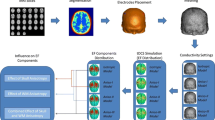Abstract
Background
Direct electrical stimulation of cortical and axonal areas is widely used for brain mapping of functional areas during intraparenchymatous resections. However, there are very few data (be they experimental or computational) regarding the exact volume of activated axons surrounding the bipolar electrodes. The aim of this study was to provide a computational model to estimate the regions in which electrical stimulation will generate an action potential in the axons.
Methods
An axonal fasiculus was modeled as a homogenized bidomain medium. Passive membrane dynamics was implemented at the interface between the two domains. The resulting set of equations was numerically solved by the finite element method.
Results
Simulations show that the activated volumes are located in the vicinity of each electrode. The volume of the activated regions grows linearly with intensity. The direction of the bipolar tips (parallel or orthogonal to the fibers’ axis) does not significantly influence the size of activated regions.
Conclusions
This computational study suggests that directing the bipolar electrodes orthogonal to the axis of a fasciculus should facilitate its identification, as the chances are higher in this configuration that at least one of the electrode tips will be in contact with a fasciculus. Experimental studies are needed to confirm this model prediction.





Similar content being viewed by others
References
Basser PJ, Roth BJ (2000) New currents in electrical stimulation of excitable tissues. Annu Rev Biomed Eng 2:377–397
July J, Manninen P, Lai J, Yao Z, Bernstein M (2009) The history of awake craniotomy for brain tumor and its spread into Asia. Surg Neurol 71:621–624, discussion 624–625
Karnath HO, Borchers S, Himmelbach M (2010) Comment on “Movement intention after parietal cortex stimulation in humans”. Science 327:1200, author reply 1200
Mandonnet E, Pantz O (2011) On the activation of a fasciculus of axons. Rapport interne CMAP Numero 714:http://www.cmap.polytechnique.fr/preprint/. Accessed 8 Jun 2011.
Mandonnet E, Winkler PA, Duffau H (2010) Direct electrical stimulation as an input gate into brain functional networks: principles, advantages and limitations. Acta Neurochir (Wien) 152:185–193
Martinek J, Stickler Y, Reichel M, Mayr W, Rattay F (2008) A novel approach to simulate Hodgkin-Huxley-like excitation with COMSOL Multiphysics. Artif Organs 32:614–619
McIntyre CC, Grill WM (1999) Excitation of central nervous system neurons by nonuniform electric fields. Biophys J 76:878–888
McIntyre CC, Hahn PJ (2010) Network perspectives on the mechanisms of deep brain stimulation. Neurobiol Dis 38:329–337
Neu JC, Krassowska W (1993) Homogenization of syncytial tissues. Crit Rev Biomed Eng 21:137–199
Rattay F (1999) The basic mechanism for the electrical stimulation of the nervous system. Neuroscience 89:335–346
Conflicts of interest
None.
Author information
Authors and Affiliations
Corresponding author
Additional information
Comment
The authors proposed a computational model of the complex processes involved in direct brain electrostimulation using a bipolar probe (60 Hz, current-constant biphasic stimulation, 1-ms pulse). They restricted their study to the case of axonal stimulation, i.e., to the estimation of the regions in which electrical stimulation will generate an action potential in the axons. They observed that the activated volumes were located in the vicinity of each electrode, whereas in between the two electrodes, there was virtually no activation. They also found that the volume of the activated regions grew linearly with intensity, and that the direction of the bipolar tips did not significantly influence the size of activated regions.
This is a very interesting article. The rationale is original, and the methodology is robust. Very few data are currently available about the mechanisms underlying electrostimulation mapping. Computational modeling represents an elegant solution to improve our understanding of the interaction between neuronal elements and electrical stimulation, with the aim to optimize the clinical results. The authors show that, if during the past decade huge efforts have been devoted for developing computational models in the field of deep brain stimulation, the situation is somehow similar in the settings of axonal stimulation during awake mapping. In practice, it means that the surgeon has to direct the bipolar probe orthogonally and not parallel to the axis of a fascicle in order to optimize the chances to detect the functional fibers during the mapping of the subcortical connectivity. As a consequence, this paper may have useful surgical implications, even if experimental studies are, of course, needed to validate the model prediction.
Hugues Duffau
Montpellier, France
Rights and permissions
About this article
Cite this article
Mandonnet, E., Pantz, O. The role of electrode direction during axonal bipolar electrical stimulation: a bidomain computational model study. Acta Neurochir 153, 2351–2355 (2011). https://doi.org/10.1007/s00701-011-1151-x
Received:
Accepted:
Published:
Issue Date:
DOI: https://doi.org/10.1007/s00701-011-1151-x




